South Florida Plants for Shade (With Pictures)
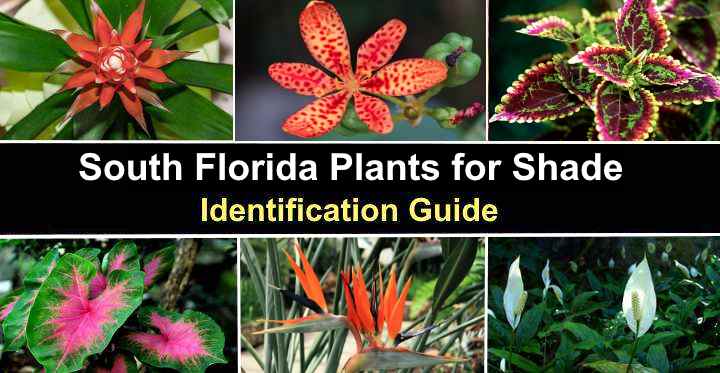
Choosing the right plants for shade in South Florida can be challenging. Shade plants growing in USDA zone 10 must tolerate a tropical climate and survive on a few hours of sunshine or complete shade. Depending on your garden landscape, you may need shade-tolerant flowering shrubs, perennials, or low-growing plants that grow well in the shadows of structures, tall trees, or shrubs.
Many South Florida plants can tolerate heavy to partial shade in hot, tropical climates. Popular flowering plants for shade include tropical irises, pinwheel jasmine, and bromeliads. Some common low-growing shade plants for zone 10 include creeping pilea, dwarf chenille, and mondo grass.
The good news is that it is possible to add color and texture to shaded areas in your yard. With the right shade-loving plants, you can landscape your garden with shrubs, tall plants, flowers, and ground cover plants despite growing in a lack of direct sunshine.
What are the best tropical shade plants to grow in Florida? This article describes the features of over 30 heat and shade-tolerant plants. In addition, pictures of plants that grow in the shade will help you choose the best type of your southern garden.
What are Shade Plants for South Florida?
Shade plants for growing in South Florida landscapes must tolerate limited direct sunlight in tropical climates. The shade-tolerant plants are ideal for planting along a fence line, in a north-facing garden, under larger shrubs, or in constant shadows. Some shade plants need hardly any direct sunshine, whereas others are ideal for partial shade or dappled sunlight.
Plants for shade in South Florida are suitable for USDA zone 10. This tropical region in the Sunshine State is south of Lake Okeechobee. It is from Fort Myers on the Gulf Coast to Vero Beach on the Atlantic Coast. Florida’s zone 10 also includes the coastline as far north as Tampa and Palm Bay. Zone 11 extends to the Florida Keys.
Shade-tolerant plants in South Florida require varying levels of sunlight, depending on the plant. For example, full-shade plants get by on an hour of sunlight daily. However, plants for partial shade can mean two hours of sunlight—typically morning sunshine to ensure good growth. Light shade plants require three to five hours of direct sunlight.
How to Choose Shade Plants for South Florida Landscape?
When choosing plants for your shady South Florida landscape, pick shrubs, flowers, or low-growing varieties suitable for the sun exposure they get. If the yard is in constant shade, then full-shade plants are ideal. However, areas of your yard with morning or afternoon sun require plants for partial shade.
To ensure you pick the best shade plants for South Florida, check to see if the growing zone is suitable for zones 10. Remember that some plants need very little direct sunlight while others need more.
Other considerations when choosing shade-happy plants for your South Florida garden are the type of foliage—evergreen or deciduous, maintenance requirements, size, pruning, flower color, and watering schedule.
South Florida Plants for Shade (With Pictures) — Identification Guide
Let’s look in detail at shade plants suitable for southern Florida landscapes south of Lake Okeechobee. These shade-tolerant plants are divided into four categories—flowering shade plants, tall shade plants, shrubby shade plants, and low-growing shade plants.
Flowering Shade Plants For South Florida
Blooming shade plants are ideal for adding a pop of color to a shaded South Florida landscape. Thanks to Florida’s tropical climate, some native flowering plants blossom throughout the year and don’t lose their leaves.
Here are some of the best flowering shade plants for south Florida.
Tropical Irises
Tropical irises are beautiful flowering perennial plants that tolerate partial and dappled shade. Most irises of South Florida are characterized by their clumping, creeping habit, sword-like leaves, and showy flowers with open petals. These eye-catching flowering shade plants are ideal for understory planting, where they can thrive in deep, well-drained soil.
Here are some varieties of irises that thrive in the shade and tolerate Florida’s intense heat and humidity:
African Iris (Dietes vegeta)
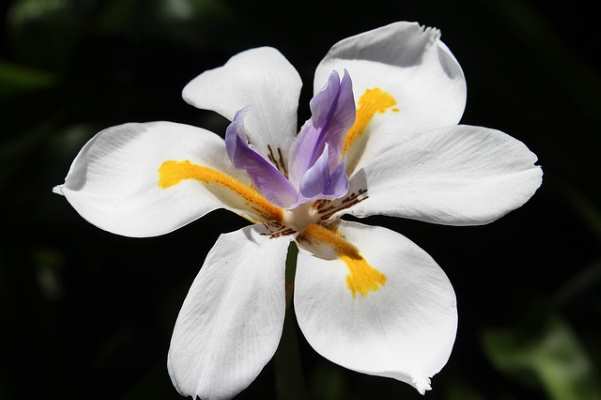
The African iris thrives outdoors throughout the year in areas south of West Palm Beach and Fort Myers to the Florida Keys. Identifying features of African irises are their 3” (7.5 cm) white flowers with purple and yellow centers, tall, slender, lanceolate leaves, and tolerance to wet soil.
African irises are ideal for accenting short ground cover in partially shaded conditions. The leaf blades grow 12” to 36” (30 – 90 cm) tall. In warm climates, the leaves are evergreen, and the creeping plant spreads up to 2 ft. (0.6 m) wide.
USDA zone: 9 to 11
Size: 2 to 6 ft. (0.6 – 1.8 m)
Sun exposure: Partial shade or dappled sunlight
Walking Iris (Neomarica)
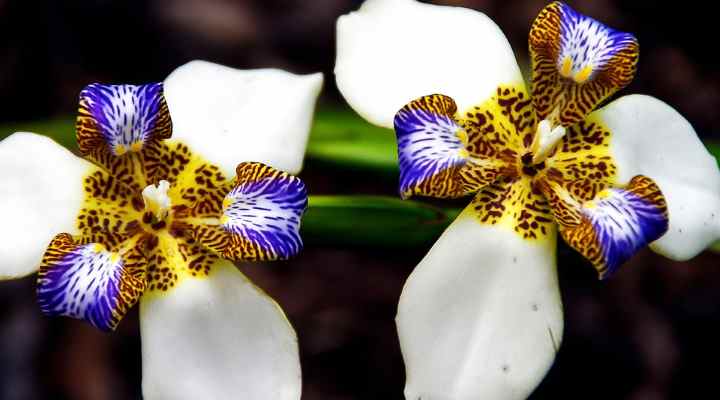
Walking iris (Neomarica gracillis)
The walking iris is a clumping herbaceous perennial that thrives in all of Florida’s growing zones—from the Panhandle to the Keys. This tropical iris is known for its showy flowers, glossy green leaves, and unique spreading nature. The spectacular blooms have three large outer petals and several striped inner petals.
Walking irises are ideal flowering plants for partial or deep shade. Its evergreen foliage in zones 10 and 11 provides South Florida gardens with year-long interest. It is also a suitable plant for growing in wet soil, like beside a stream or pond.
USDA zone: 9 to 11
Size: 3 ft. (1 m) tall and 2 ft. (0.6 m) wide
Sun exposure: Partial shade or heavy shade
Blackberry Iris (Belamcanda chinensis or Iris domestica)

The blackberry iris is an erect, spreading perennial with eye-catching reddish-orange flowers and sword-shaped green leaves. The iris flowers have six red-spotted orange petals with three to 12 flowers on an erect stem. The blackberry iris has an unusual feature—its fruit resembles large blackberries that persist on the plant through winter.
Blackberry irises are perfect flowers for dappled shade. The contrast of deep orange petals with medium green leaves adds a splash of color to South Florida yards. Plant in humus-rich, moist soil that drains well.
USDA zone: 5 to 10
Size: 2 to 3 ft. (0.6 – 1 m) tall and 2 ft. (0.6 m) wide
Sun exposure: Full sun to dappled shade
Blue Flag (Iris virginica)

The blue flag iris is a native Florida flowering plant that thrives in partially shaded locations. Like many tropical iris plants, the blue flag variety grows in dense clumps. Its deep purple-blue perennial flowers measure 4” (10 cm) across. Its slender, curled petals have touches of yellow, lavender, and dusty white.
This native plant species thrives in wet soil and partial shade. In drier locations in South Florida, you can plant blue flag irises in deeper shade. However, regardless of soil type, you should keep the plants away from direct sunlight.
USDA zone: 9 to 11
Size: 4 to 7 ft. (1.2 – 2.1 m) tall and up to 3 ft. (1 m) wide
Sun exposure: Partial sun to partial shade
Pinwheel Jasmine (Gardenia jasminoides ‘Pinwheel’)
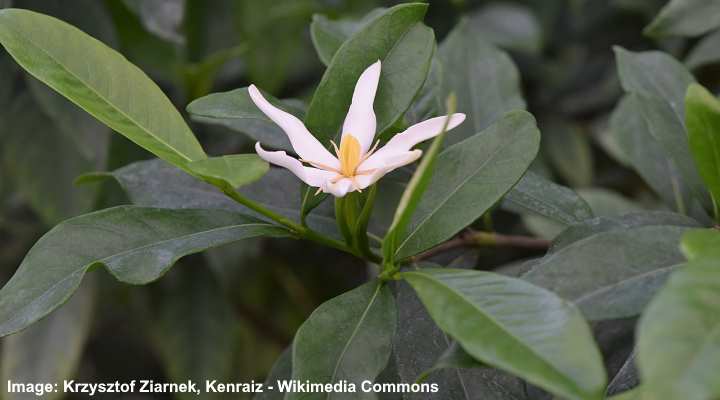
Pinwheel jasmine is an evergreen shrub for south Florida that doesn’t need much sunlight. The tropical plant’s abundance of fragrant white flowers blooms continuously from late spring through fall. Ideal for partial or light shade conditions in southern Florida, the lush shrub has five-petalled pinwheel flowers, thick, leathery green leaves, and a rounded habit.
Also called cape jasmine, this white-flowering shrub has an intoxicating aroma when in bloom. You can grow pinwheel jasmine as a tropical flowering evergreen hedge, specimen plant, or container garden. Additionally, its white, fragrant flowers attract pollinators like bees and butterflies.
Grow this tropical plant in a Florida landscape in acidic soil that is well-drained and organically rich.
USDA zone: 6 to 11
Size: 4 ft. (1.2 m) tall and wide
Sun exposure: Full sun to light shade
Peace Lily (Spathiphyllum)
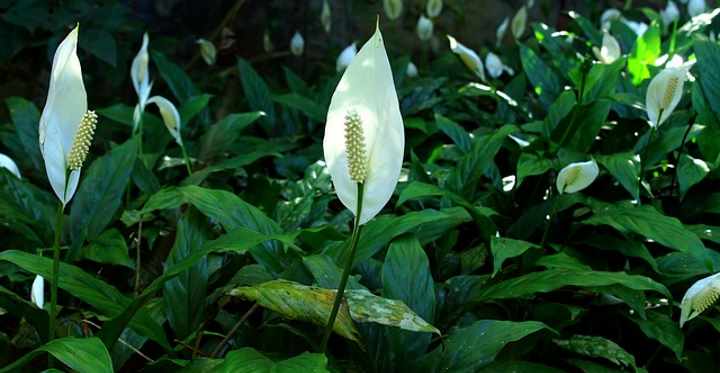
Peace lily is a tropical plant that thrives in low-light conditions in south Florida gardens. The identifying features of this evergreen plant are its beautiful white flowers that resemble calla lilies, dark green, lustrous leaves, and tolerance for heavy shade. The white sail-like flowers grow on tall stems, contrasting with the large, glossy leaves.
Peace lily leaves are large and measure up to 25” (63 cm) long and 10” (25 cm) wide. The white spathe flowers are tubular with a large greenish-white lance-shaped bract. They measure 12” (30 cm) tall.
Peace lilies only grow outdoors in warm, humid climates at the southernmost tip of Florida’s peninsula. They can thrive in fewer than 2 hours of sunlight per day. The deep shade tolerance of peace lilies means they thrive where other flowering plants struggle.
In northern areas of Florida or cooler climates, peace lilies are popular indoor plants because they don’t need sunlight.
USDA zone: 11 and 12
Size: 1 to 6 ft. (0.3 – 1.8 m) tall and up to 5 ft. (1.5 m) wide
Sun exposure: Partial shade to deep shade
Bolivian Sunset (Gloxinia sylvatica)
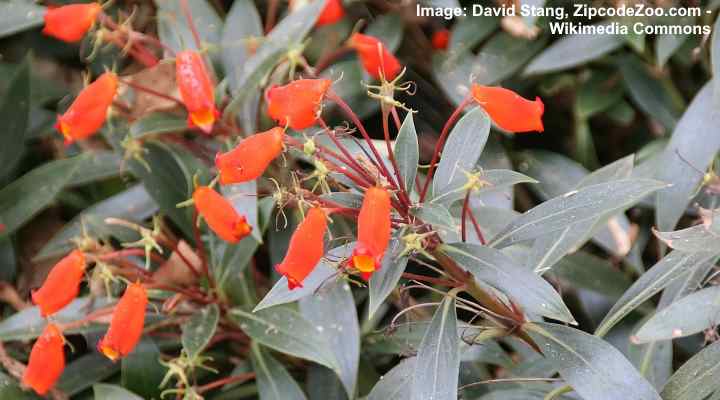
The Bolivian sunset plant is a beautiful shade shrub with bright orange-red tubular flowers that bloom all year round. The clusters of cylindrical red flowers grow on terminal stems and bloom from mid-fall through winter. Its bright red flowers contrast with the lance-shaped gray-green leaves. It is suitable for planting south of Lake Okeechobee and the Florida Keys.
Bolivian sunset is an attractive shrubby plant that thrives in sunny or shaded conditions. You can use the low-maintenance flowering plant as ground cover, a border plant, or to grow in containers. Its tropical flowers thrive in the shade, helping to brighten yards along a fence line, in constant shadows, or under trees.
USDA zone: 8 to 11
Size: 2 ft. (0.6 m) tall and wide
Sun exposure: Sun, partial shade, and deep shade
Bromeliads
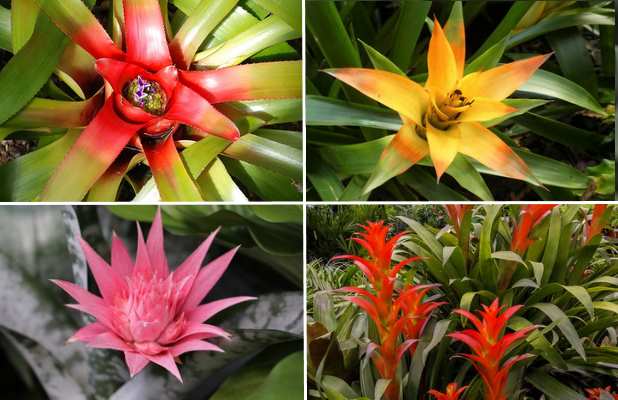
Bromeliads are a diverse group of tropical plants performing well in South Florida without much sunshine. These unusual plants are identified by their vibrant colors, exotic foliage, and long-lasting, stunning flowers. The epiphyte plants have leaves and flowers similar to a pineapple’s top. Florida is home to 16 native bromeliad varieties.
Bromeliads thrive in frost-free tropical and subtropical climates. There are several varieties suited to growing in deep shade. Like all types of epiphytes, bromeliads get moisture and nutrients from humidity in the air. Therefore, they are well-suited to growing outdoors in South Florida’s hot, humid environment.
USDA zone: 9 to 12
Size: Up to 3 ft. (1 m) tall, depending on the variety
Sun exposure: Full sun to deep shade, depending on the variety
Fire Spike (Odontonema cuspidatum)

Fire spike is a perennial flowering plant suitable for growing in south Florida. The flowering shade plant is known for its strikingly beautiful red 3” (7.5 cm) flowers growing on tall flower spikes. The heat and drought-tolerant plant is perfect for adding a pop of red colors to shady spots in your yard.
Although the best blooming happens in full sun, red-flowering fire spike also performs well in partial shade. You can plant the ornamental shrub as a specimen plant, hedge, or accent shrub. Its fragrant red tubular flowers also attract pollinators and hummingbirds.
USDA zone: 10 and 11
Size: 4 to 6 ft. (1.2 – 1.8 m) tall
Sun exposure: Full sun to partial shade
Persian Shield (Strobilanthes dyerianus)
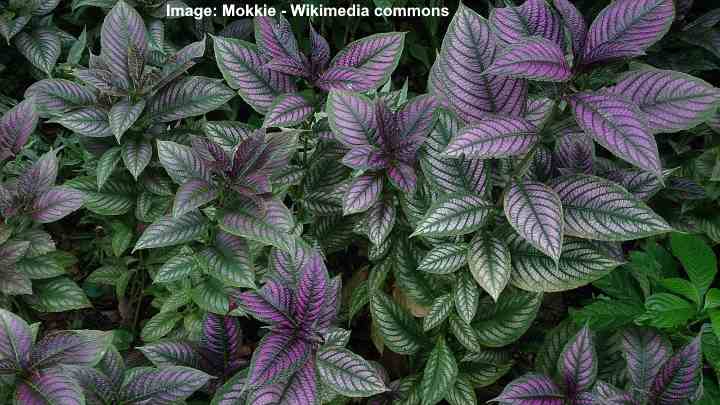
The Persian shield is a stunning shade plant for South Florida thanks to its eye-catching dark green, lilac, and deep purple iridescent large leaves. This evergreen perennial has shimmering leaves that grow 4” to 7” (10 – 18 cm) long. Persian shield also blooms with small purple flowers in winter.
Thriving in warm, humid climates, Persian shield is the perfect foliage landscaping plant for Florida. You should plant it in well-drained, moist soil in partial to full shade. In USDA zone 8 and 9, the perennial shade plant dies back to the ground in winter. However, in South Florida, its evergreen foliage grows throughout the year.
USDA zone: 8 to 11
Size: Up to 3 ft. (1.5 m) tall and 3 ft. (1 m) wide
Sun exposure: Partial shade to full shade
Low Growing Shade Plants for South Florida
Low-growing shade plants for Florida’s climate are ideal for ground cover, to reduce maintenance and weeds, and help make a shady garden look more attractive.
Carolina Wild Petunia (Ruellia caroliniensis)
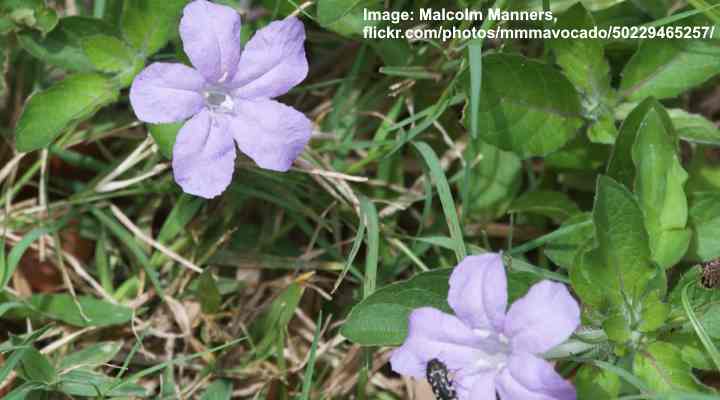
Carolina wild petunia is a native perennial plant that loves the shade in Florida’s Peninsula. The flowering plant produces clusters of lavender trumpet-shaped blooms with five ruffled petals. The papery flowers bloom from late spring through summer. The funnel flowers contrast with the oval leaves that measure up to 4” (10 cm) long.
Carolina wild petunia grows up to 1 ft. (0.3 m) tall and spreads 2 ft. (0.6 m) wide. The low-maintenance plant self-seeds and is ideal for shaded ground cover or planting in cottage gardens, mixed borders, mass plantings, or hanging baskets. Because of its tolerance to full shade, it’s an ideal understory flowering plant.
USDA zone: 8 to 11
Size: 0.5 to 1 ft. (15 – 30 cm) tall and 2 ft. (60 cm) wide
Sun exposure: Part shade to deep shade
Begonias

Begonia rex ‘Zurich’
Most varieties of begonias are shade plants that thrive in USDA zones 10 and 11. The best begonia types for a shaded yard are rex begonias, hardy begonias, cane begonias, and rhizomatous begonias. These low-growing plants don’t need much sunshine to bloom profusely or develop colorful foliage.
Here are descriptions of a few types of shade-loving begonias suitable for southeastern gardens:
Rex begonias—Known for striking foliage with silvery, purple, and green patterns. Some varieties have a spiral, snail-like pattern on round leaves, and others have large colorful heart-shaped leaves. Suitable for partial shade.
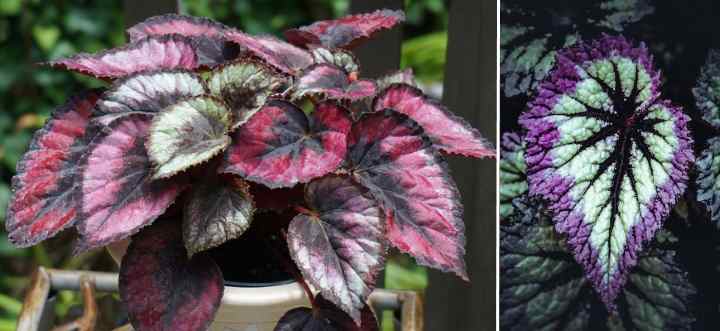
Cane begonias—These shade-tolerant plants have dangling clusters of flowers, creating stunning floral displays for hanging baskets. Ideal for growing in partial sun to full shade.
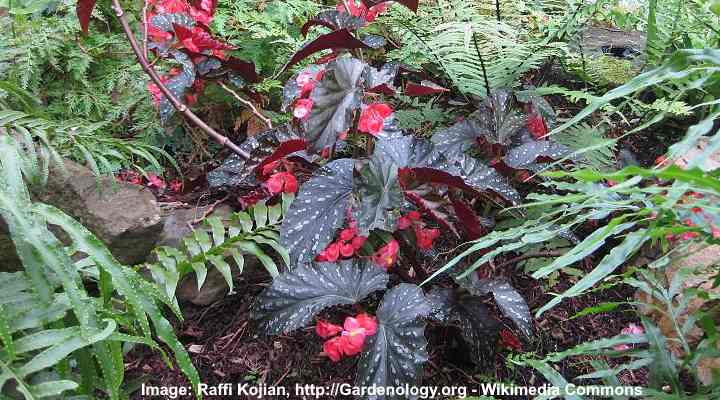
Angel wing begonia (in the picture) is a type of cane begonia
Hardy begonias—These low-growing shrubby plants have stunning foliage and small pink or red flower clusters. These are fast-growing foliage plants, ideal for ground cover in full shade.
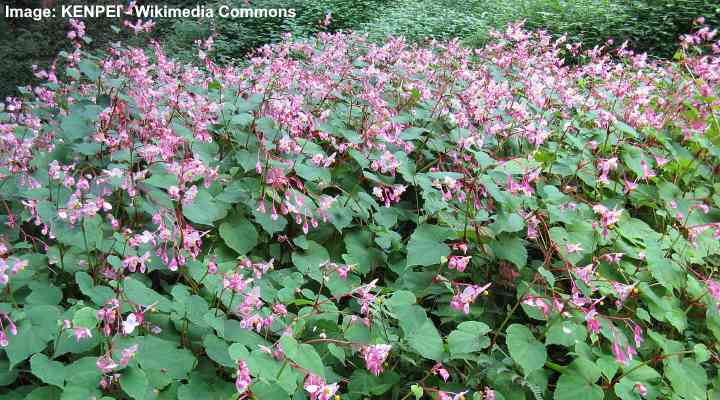
Begonia grandis (in this image) is a hardy begonia species
USDA zone: 9 to 11
Size: 0.5 to 3 ft. (15 – 90 cm) tall wide
Sun exposure: Partial sun to full shade
Baby Rubber Plant (Peperomia obtusifolia)
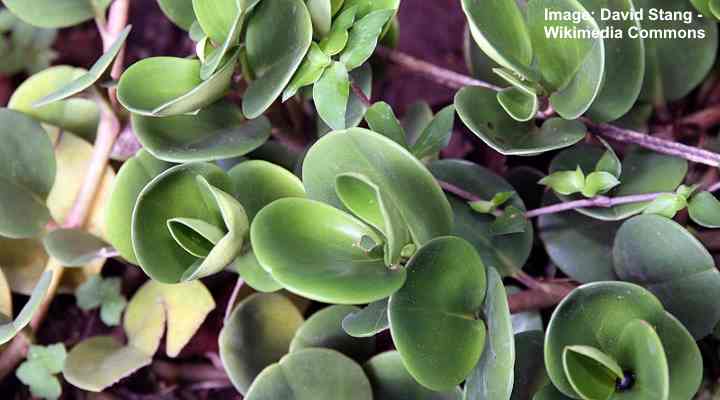
The baby rubber plant is a low-growing, shade-tolerant perennial creating a waxy, green foliage mat. This ground-hugging south Florida shade plant has small oval leathery leaves 2” to 4” (5 – 10 cm) long growing on reddish-brown stems. The fast-growing plant is ideal for evergreen ground cover in tropical, humid climates.
The baby rubber plant is a low-maintenance plant in a shade garden as long as it stays out of sunlight. The tropical perennial requires rich, organic soil that drains well and is perfect for partial to deep shade. Although the plant produces clusters of small creamy-white flowers, these are insignificant compared to its glossy foliage.
USDA zone: 9 to 12
Size: 0.5 to 1 ft. (15 – 30 cm) tall and wide
Sun exposure: Partial sun to deep shade
Mondo Grass (Ophiopogon japonicus)

Mondo grass is a popular choice for adding lush greenery to shady areas in South Florida. This low-maintenance plant grows as tufts of dark green, grass-like blades. The tough, durable evergreen grass alternative is ideal for shady areas in a tropical front or backyard where it grows without much attention.
Mondo grass is perfect for Florida’s landscapes because it requires little water and grows in salty soil. You can use mondo grass in shade gardens as ground cover, evergreen edging, underplanting shrubs in gravel gardens, urban landscapes, or coastal gardens.
The best place to plant mondo grass in South Florida is where it gets plenty of shade from the afternoon sun.
Related reading: How to care for mondo grass.
USDA zone: 7 to 10
Size: 10” to 12” (25 – 30 cm) tall and 12” to 24” (30 – 60 cm) wide
Sun exposure: Full sun to partial shade
Dwarf Chenille Plant (Acalypha reptans)
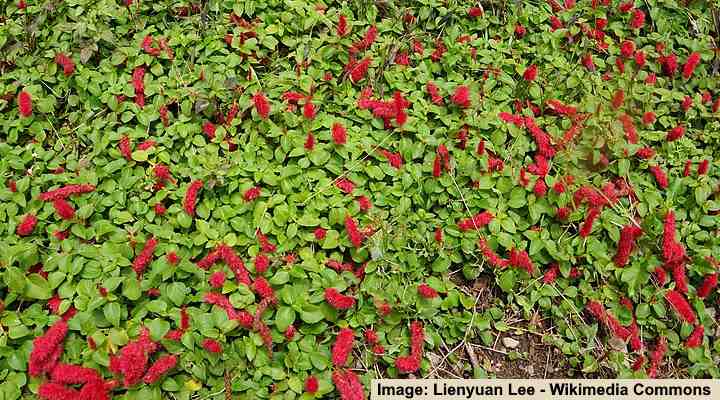
Dwarf chenille is a red-flowering, low-growing plant for shaded Florida landscapes. The ground cover plant is recognized by its bright red bottlebrush flowers, small egg-shaped serrated leaves, and mounding growth habit. The fuzzy red upright flowers contrasting with the dark evergreen foliage add year-long interest in shade gardens.
Ideal for adding color and texture where sunlight is limited, dwarf chenille is perfect as an understory red-flowering ground cover plant. Additionally, it looks attractive as low-growing edging along walkways and paths or to highlight foundation plantings in the front of the house.
USDA zone: 10 and 11
Size: Up to 6” to 18” (15 – 45 cm) tall and wide
Sun exposure: Partial sun or partial shade
Creeping Pilea (Pilea nummulariifolia)

Also called creeping Charlie, creeping pilea is a mat-forming shade plant with bright green, rounded leaves with scalloped edges. This low-growing, spreading plant performs best in dappled shade or deep shade in USDA zones 10 and 11. Creeping pilea has rapid growth, creating a lush carpet-like effect, ideal for ground cover
Native to Florida, the shade-loving plant is identified by its wrinkled leaves. However, in some climates, the fast-growing ground-hugging plant can become invasive. In cooler zones, creeping pilea is a good trailing plant for indoor containers or hanging baskets.
USDA zone: 10 and 11
Size: 4” to 8” (10 – 20 cm) tall and up to 23” ft. (60 cm) wide
Sun exposure: Partial sun or partial shade
Caladiums
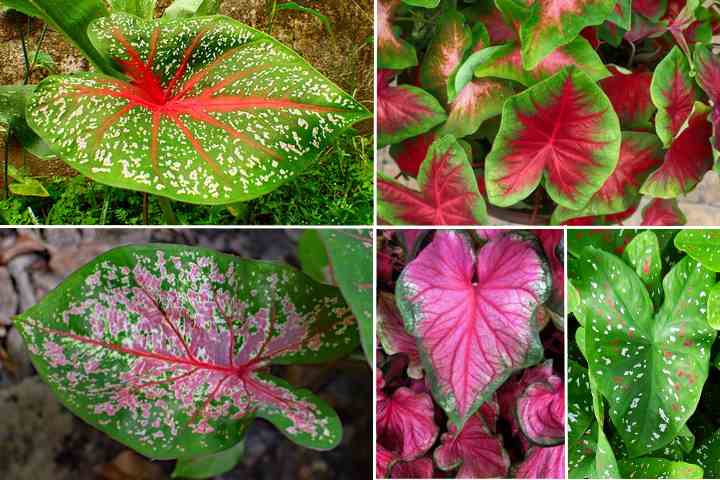
Caladiums are tropical foliage plants that add vibrant color and texture to south Florida shade gardens. Caladium plants are known for their heart-shaped, colorful leaves with bright pink, red, or white veins, speckles, or spots. Also called angel wings, caladium leaves can grow up to 6” (15 cm) long and 3” – 6” (7.5 – 15 cm) wide.
The vibrant foliage colors of caladium are more pronounced when growing in partial to deep shade. The stunning fancy-leaved or strap-leaved varieties make a strong statement in tropical garden landscapes. You can plant them to brighten shady beds and borders or create colorful displays in containers.
Related reading: How to care for caladiums.
USDA zone: 9 to 12
Size: 1 to 2 ft. (0.3 – 0.6 m) tall and wide
Sun exposure: Partial sun to full shade
Coleus

Coleus is a colorful and easy-to-grow low-growing group of plants to brighten shade gardens in South Florida landscapes. Coleus plant leaves are typically ovate, pointed leaves with scalloped edges. The brightly colored foliage can be shades and combinations of lime green, bright yellow, vibrant red, neon purple, or chocolate brown.
Coleus foliage requires deep shade to develop the dazzling colors that decorate the velvety leaves. The low-growing colorful, mint-like leaves are perfect for landscape beds, shade borders, container gardens, or hanging baskets on a patio. Coleus plants are the “go-to” annual bedding plant for garden landscapes in cooler climates.
USDA zone: 10 and 11
Size: 1 to 3 ft. (0.3 – 1 m) tall 3 ft. (1 m) wide
Sun exposure: Dappled shade, limited morning sunlight, or partial shade
Tall Shade Plants
Tall shade plants are excellent for planting in South Florida’s zone 10. From dwarf palm trees to tall, flowering plants, there are plenty of options to add vertical height in a shade garden in the Sunshine State.
Florida Thatch Palm (Thrinax radiata)
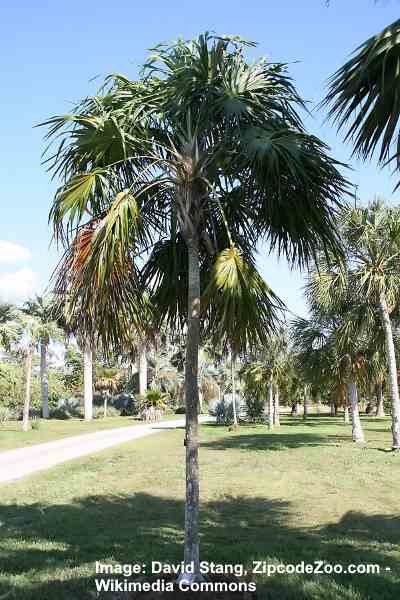
The Florida thatch palm is a native southern palm tree that adds a tropical touch to southern gardens. The thatch palm tree thrives in partial shade to full sun. It is identified by its slender, vertical gray trunk, rounded canopy of 12 to 20 drooping fan-shaped palm leaves, and clusters of white flowers.
Native to the Florida Keys, the thatch palm is also called the sea thatch palm or silk-top palm. Thanks to its limited size of 20 ft. (6 m) and shade tolerance, it’s a perfect choice of palm for a compact, tropical garden. Ideal growing conditions are sandy soil with good drainage and plenty of humidity.
USDA zone: 10 and 11
Size: 15 to 20 ft. (4.5 – 6 m) tall and 6 ft. (1.2 m) wide
Sun exposure: Full sun to partial shade
Hanging Lobster Claw (Heliconia rostrata)
![]()
Hanging lobster claw is a tropical plant that thrives in full sun or partial shade. Suitable for USDA zone 10, the shade plant has stunning clusters of red and yellow flowers shaped like lobster claws. The dangling colorful flowers grow 3 to 5 ft. (1 – 1.5 m) long.
Hanging lobster claw is ideal for planting near a water feature or as a specimen plant in a tropical garden. During the hot summers of South Florida, the plant requires regular watering to thrive. These stunning plant flowers bloom for several weeks, and the nectar-rich red blooms attract hummingbirds.
USDA zone: 10 and 11
Size: 4 to 6 ft. (1.2 – 1.8 m) tall and 3 to 6 ft. (1 – 1.8 m) wide
Sun exposure: Partial sun or shade
Variegated Ginger (Alpinia zerumbet ‘Variegata’)

Variegated ginger is a beautiful and versatile shade plant that thrives in the hot and humid climate of South Florida. The bushy foliage plant has arching stems with striking variegated leaves with green and bright yellow markings. Additionally, the variegated plant has unusual white flowers that look like seashells—a reason why it’s also called the shell plant.
Variegated ginger is a low-maintenance plant for shady spots. Thanks to its rounded growth and bushy appearance, it’s an excellent choice for foundation plantings or for color and texture in a southern garden or landscape. It also works well as a border planting in light shade.
USDA zone: 8 to 10
Size: 3 to 6 ft. (1 – 1.8 m) tall and 5 to 8 ft. (1.5 – 2.4 m) wide
Sun exposure: Full sun to part shade
Bird of Paradise (Strelitzia reginae)

Bird of paradise is a tropical plant that thrives in full sun and produces unique, showy flowers. The identifying features of this eye-catching plant are its striking orange and blue flowers resembling a bird’s head and its large oval gray-green leaves. The unique pointed flowers grow on long stems and bloom throughout the year.
Also called crane flowers, bird of paradise flowers add a vibrant splash of colors to partially shaded garden areas. When not blooming, the evergreen foliage forms a mound of large leaves resembling a banana plant.
USDA zone: 10 to 12
Size: 5 to 6 ft. (1.5 – 1.8 m) tall and 4 ft. (1.2 m) wide
Sun exposure: Full sun to partial shade
Shrubby Shade Plants
South Florida’s lush tropical climate offers gardeners a wide range of options when choosing shrubs that thrive in full shade or partial shade. Here are some outstanding shrubs to add color and greenery to shady spaces.
Dwarf Azalea

Dwarf azalea shrubs are excellent plants to add color and texture to a shaded South Florida yard. Evergreen azaleas are adorned with showy funnel-shaped flowers in shades of pink, lilac, white, red, yellow, and orange. Many dwarf evergreen flowering azalea shrubs don’t grow more than 4 ft. (1.2 m) tall.
Azalea shrubs enhance the aesthetics of yards in several ways and boost curb appeal. You can plant the sprawling shrubs along a foundation line, in mass borders, or as specimen plants. In Florida, azaleas bloom from late February through April.
Consider the growing zone when choosing azalea shrubs for a South Florida yard—not all azaleas are suitable for tropical or subtropical zones. Typically, dwarf azaleas from the Encore series are suitable for partial shade in zone 10. Or, there is the native Florida flame azalea (Rhododendron austrinum) which has yellow or orange honeysuckle flowers and thrives in areas south of Fort Myers.
USDA zone: 6 to 10
Size: 2 to 6 ft. (0.6 – 1.8 m) tall and wide
Sun exposure: Full sun to partial shade
Swamp Dogwood (Cornus foemina)
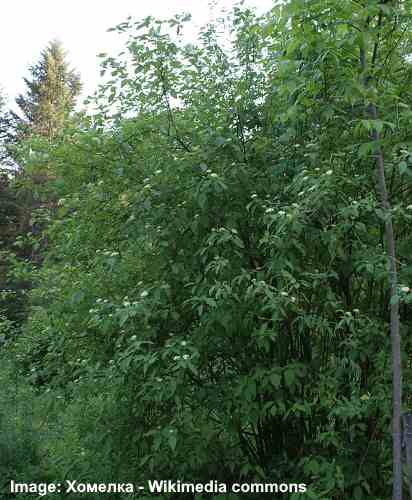
Swamp dogwood is a shade-loving native shrub with flat-topped clusters of creamy white flowers. This shrubby shade plant is known for its long-lasting white blooms, attractive red stems, reddish-purple fall colors, lance-shaped green leaves, and bright blue berries. The large shrub thrives in moist to wet, well-drained soils.
Swamp dogwood is a versatile plant that thrives in wet or dry soil conditions and direct sunlight or shade. This makes the heat-loving shrub ideal for planting in South Florida yards. In addition, the shade shrub performs well as a shrub border, foundation plantings, or near ponds and streams.
USDA zone: 6 to 10
Size: 10 to 25 ft. (3 – 7.5 m) tall and up to 10 ft. (3 m) wide
Sun exposure: Full sun, dappled sun, or shade
Wild Coffee (Psychotria nervosa)
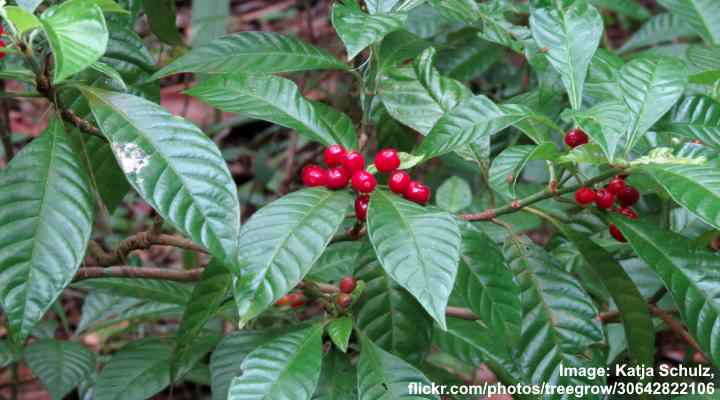
Wild coffee is a native Florida shrub, ideal for part-shade or full-shade conditions. The evergreen flowering shrub features dark green leaves, clusters of small white tubular flowers blooming in spring and summer, and clusters of edible red berries. Additionally, the shrub is drought and salt-tolerant and requires little maintenance.
The wild coffee shrub gets its name from the oval berries resembling coffee beans. You can plant the shrub as an accent plant, an evergreen hedge, or a foundation planting.
Wild coffee is said to be the most widely cultivated of Florida’s native shrubs.
USDA zone: 9 to 11
Size: 2 to 10 ft. (0.6 – 3 m) tall and 3 to 5 ft. (1 – 1.5 m) wide
Sun exposure: Partial sun to deep shade
Bloodberry (Rivina humilis)
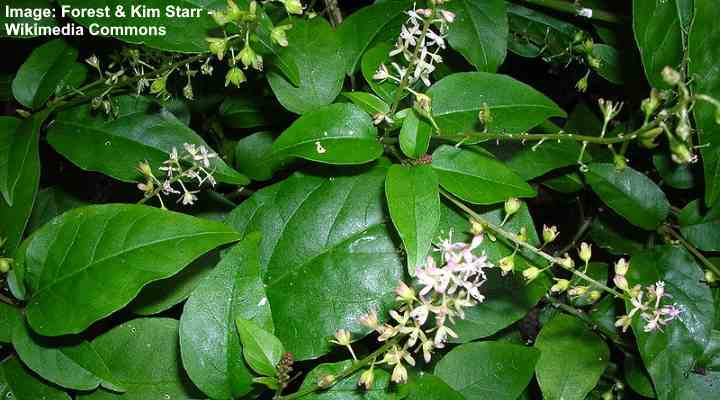
Bloodberry is a shade-tolerant flowering shrub native to Florida. This shade plant thrives in USDA zones 10 and 11, making it an ideal landscape plant for South Florida yards. The attractive features of bloodberry are its white to pink flower clusters, vibrantly red berries, and large ovate leaves hanging on long petioles.
Bloodberry is an excellent fast-growing shade shrub for planting in mixed borders, as a specimen plant, or as a hedge. Its low maintenance and tolerance to poor soil, drought, and deep shade make it popular in southern garden landscapes.
USDA zone: 7 to 11
Size: 3 to 5 ft. (1 – 1.5 m) tall and up to 3 ft. (1 m) wide
Sun exposure: Partial shade to full shade
Coontie (Zamia pumila)

Coontie is a unique and interesting woody shrub native to central and southern Florida. The clumping plant is known for its fern-like appearance with stiff pinnate leaves, reddish-brown egg-shaped cones, and tolerance to heat, drought, and salty wind.
This evergreen cycad is common in tropical South Florida landscapes as ground cover, a specimen shrub, foundation planting, or a border plant. The shrub thrives in the shade and dry, sandy, well-drained soils—making it ideal for beachside locations.
USDA zone: 8 to 11
Size: 2 to 3 ft. (0.6 – 1 m) tall and 2 to 4 ft. (0.6 – 1.2 m) wide
Sun exposure: Full sun or partial shade
Jacobina Pink or Flamingo Flower (Justicia carnea)
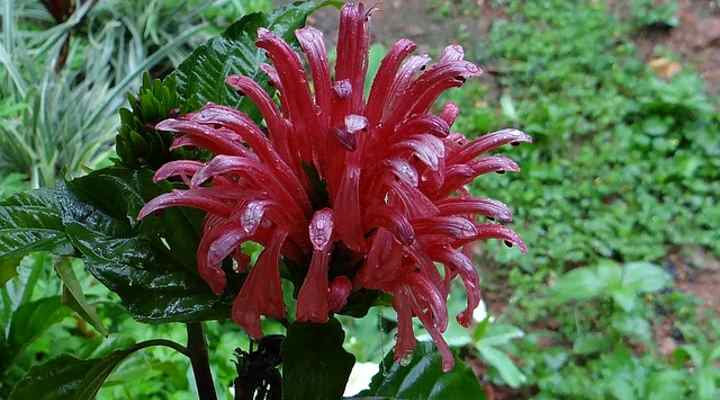
Jacobina pink is a tropical evergreen shrub that thrives when shaded from sunlight. The shade-loving shrub is known for its striking pink plume-like flowers, large, dark green 10” (25 cm) leaves, and tolerance of full shade. The showy tubular flowers grow in round clusters and bloom from early summer through fall.
Also called the flamingo plant or Brazilian plume, the shrub is ideal for planting in complete shade as a specimen plant, foundation plant, or mass planting. In cooler climates, you can grow the showy shrub indoors in containers.
USDA zone: 8 to 11
Size: 4 to 6 ft. (1.2 – 1.8 m) tall and 3 ft. (1 m) wide
Sun exposure: Partial shade to full shade
Tropical Crotons (Codiaeum variegatum)
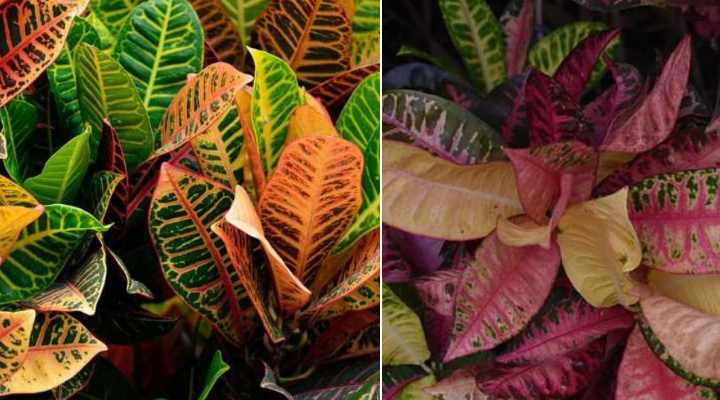
Croton plants
Tropical crotons are a group of popular ornamental plants with spectacularly colorful leaves that add a vibrant touch to a South Florida landscape. Croton plants have various leaf shapes in a range of variegated colors, including red, green, pink, purple, yellow, and orange. Plant tropical crotons to create a bold statement in your yard.
Most varieties of croton plants thrive in light or partial shade. Because they grow in zones 9 to 11, the shade plants are perfect for Central and South Florida gardens. These colorful shrubby plants are also great for adding a splash of color to borders, foundation lines or to accent other shrubs.
USDA zone: 9 to 11
Size: 3 to 8 ft. (1 – 2.4 m) tall and 3 to 6 ft. (1 – 1.8 m) wide
Sun exposure: Light shade to partial shade
Sandankwa Viburnum (Viburnum suspensum)

Sandankwa viburnum is a shade-tolerant shrub popular in South Florida landscapes. The broadleaf evergreen shrub has clusters of fragrant pink or white tubular flowers in the spring, leathery dark green oval leaves, and clusters of dark red or black berries. The shrub is suitable for planting as a specimen plant or hedge.
Sandankwa viburnum is ideal for planting in coastal landscapes, as it can tolerate salt spray and strong winds. Although it thrives in direct sunlight, the shrub performs well in dappled or partial shade.
USDA zone: 8 to 11
Size: 6 to 12 ft. (1.8 – 3.6 m) tall and wide
Sun exposure: Full sun, dappled sunlight, partial shade
American Beautyberry (Callicarpa americana)
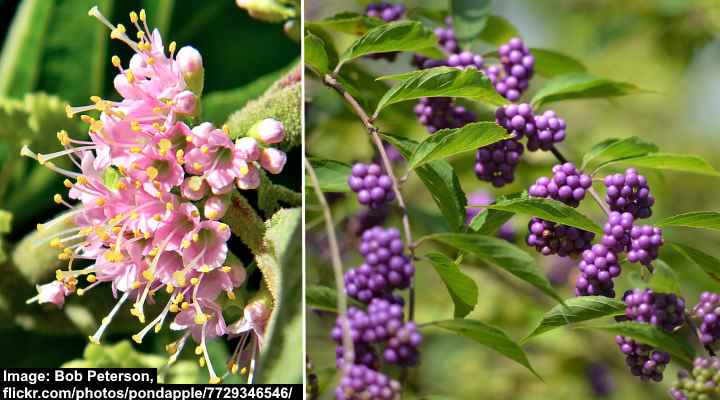
American beautyberry is a deciduous shrub that thrives in southeastern landscapes from the Panhandle to the Florida Keys. The eye-catching feature of American beautyberry shrubs is the dense clusters of vibrant purple berries in the fall. The shrub also has arching branches with fuzzy, light green leaves, pink flowers and a loose habit.
American beautyberry is an excellent choice for landscapes with protection from the hot afternoon sun. You can grow the shade-tolerant shrub as a back-of-the-border plant, specimen plant, or foundation planting. In addition, the low-maintenance shrub is drought-tolerant and requires little pruning.
Although tolerant of partial shade, it will become leggy in deep shade.
USDA zone: 6 to 11
Size: 3 to 6 ft. (1 – 1.8 m) tall and wide
Sun exposure: Full sun to partial shade
Elephant Ears (Alocasia)
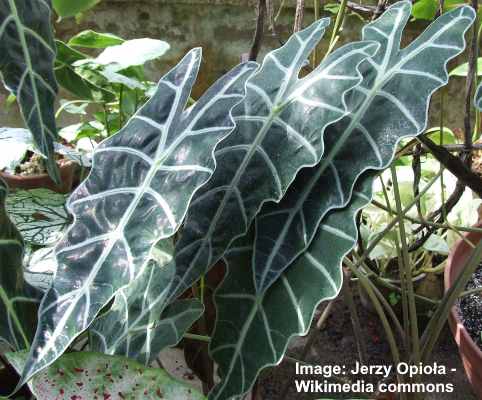
Amazonian elephant’s ear (Alocasia amazonica)
Alocasia is a genus of tropical plants famed for their large, striking leaves in the shape of a shield. Ideal for south Florida, the exotic foliage plants thrive in partial shade. The tropical heart-shaped ornamental leaves can grow up to 3 ft. (1 m) long and 2 ft. (0.6 m) wide.
The bold heart- or arrow-shaped leaves have various shades of green with stunning patterns and textures depending on the species. For best results in a southern garden, avoid direct sun exposure. In cooler climates, alocasia plants are popular houseplants.
USDA zone: 9 to 11
Size: 2 to 10 ft. (0.6 – 3 m) tall wide
Sun exposure: Partial sun or part shade
Related articles:
